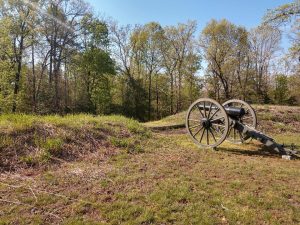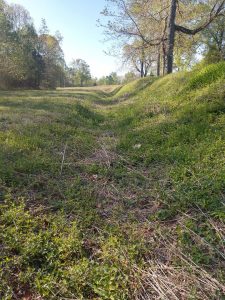Fort Harrison: What can a little-known fort teach us?
Have you ever heard of Fort Harrison, outside of Richmond? Maybe you have, if you’re well read on the Richmond campaigns, but chances are you haven’t. Built as part of the lines defending the city, the Fort was attacked and taken by Union troops on September 29, 1864. The next day Confederates tried to take it back, and failed. What can a little known fort and small battle teach us about Civil War history?
For starters, in the big picture, a historic site like Fort Harrison shows us the complexity of the war, its ups and downs. Often we see a narrative that has Confederate defeat as inevitable by 1864. After Gettysburg it was just a matter of time: sure, the Confederates fought well in the Overland Campaign, but they were just holding off the inevitable.
Yet Confederates were still confident in the late summer of 1864, pinning their hopes on the Union election that fall. Union forces had driven across Virginia in the Overland Campaign and were besieging Petersburg by September. There had been no major Union victories in the Old Dominion that summer.
Fort Harrison was the largest fort defending one of the most fortified cities in the world. It anchored a key spot on high ground in the Richmond defenses. It was built over a two year period with soldier, civilian, and slave labor. It featured large traverses, a moat, abatis, and other engineering features.
During the Union assault, troops charged over open ground, down into the moat, and scaled the steep walls. The outnumbered garrison was overwhelmed and retreated. During the fighting 23 Union soldiers earned Medals of Honor.

Both Lee and Grant were on the scene. So important was the Union attack that Grant came over from his City Point headquarters to see things for himself. So vital was the effort to retake the captured fort that Lee came up from his headquarters near Petersburg to oversee it personally.
The fort would be in Union hands for the rest of the war. The Confederates fell back, dug a new line of defenses, and both sides settled into a monotonous siege warfare. It featured daily sharp shooting and occasional barrages. For 175 days this was the front line, with Union and Confederate pickets just 600 yards apart.
That fall the fort’s garrison voted in the Presidential Election. Many states allowed its soldiers to vote absentee. Some of the USCT troops who were also voted, one of their first acts of citizenship.
From here Union troops marched into Richmond. On the night of April 2, 1865, soldiers head explosions, saw the sky glowing, and surmised the Confederates were evacuating their capital. The next day the Union troops rose early, crossed to take possession of the abandoned Confederate forts, and continued on, marching down Main Street to the Confederate Capitol.

Fort Harrison, a small, relatively little known site, contains all these stories, and more. It shows us the complexity of the war, the intersection with politics, issues of race and citizenship, siege warfare, military engineering, among other things. A visit to Fort Harrison reveals as much about the war as a stop at more famous battle sites like Antietam or Shiloh. Don’t overlook the Fort Harrison’s out there, and don’t discount the preservation of lesser known sites that may have much to teach us.
Well said. Two days earlier a fight for another fort took place hundreds of miles west. Fort Davidson, Pilot Knob, MO. Some of the same themes there – politics, race, etc. I had kin storming it, and other kin mobilizing to thwart Price’s Expedition. Today it is an excellent Missouri State Park.
Great article. I’ve visited the fort twice on tours. It’s well worth a visit.
test reply
I’ve visited once, but would love to visit again. My great great grandfather and 2 great great great uncles were part of Company L, Palmetto Sharp Shooters that tried to retake the fort. The grandfather was wounded in the shoulder and one of the uncles was killed. The other uncle was captured a week later at Darbytown Road.
Thanks for introducing Fort Harrison to me.